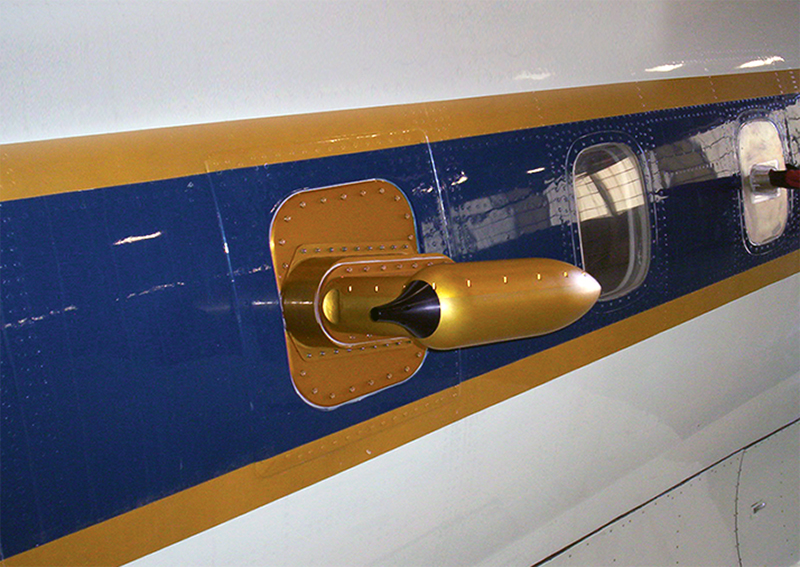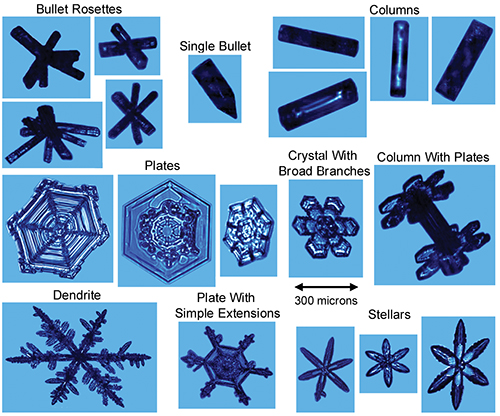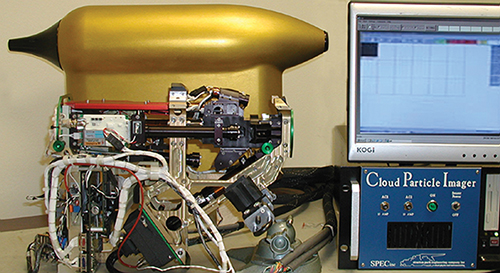
Cloud Imagers Offer New Details on Earth’s Health
Originating Technology/NASA Contribution
A stunning red sunset or purple sunrise is an aesthetic treat with a scientific explanation: The colors are a direct result of the absorption or reflectance of solar radiation by atmospheric aerosols, minute particles (either solid or liquid) in the Earth’s atmosphere that occur both naturally and because of human activity. At the beginning or end of the day, the Sun’s rays travel farther through the atmosphere to reach an observer’s eyes and more green and yellow light is scattered, making the Sun appear red. Sunset and sunrise are especially colorful when the concentration of atmospheric particles is high. This ability of aerosols to absorb and reflect sunlight is not just pretty; it also determines the amount of radiation and heat that reaches the Earth’s surface, and can profoundly affect climate.
In the atmosphere, aerosols are also important as nuclei for the condensation of water droplets and ice crystals. Clouds with fewer aerosols cannot form as many water droplets (called cloud particles), and consequently, do not scatter light well. In this case, more sunlight reaches the Earth’s surface. When aerosol levels in clouds are high, however, more nucleation points can form small liquid water droplets. These smaller cloud particles can reflect up to 90 percent of visible radiation to space, keeping the heat from ever reaching Earth’s surface.
The tendency for these particles to absorb or reflect the Sun’s energy—called extinction by astronomers—depends on a number of factors, including chemical composition and the humidity and temperature in the surrounding air; because cloud particles are so small, they are affected quickly by minute changes in the atmosphere. Because of this sensitivity, atmospheric scientists study cloud particles to anticipate patterns and shifts in climate.
Until recently, NASA’s study of atmospheric aerosols and cloud particles has been focused primarily on satellite images, which, while granting large-scale atmospheric analysis, limited scientists’ ability to acquire detailed information about individual particles. Now, experiments with specialized equipment can be flown on standard jets, making it possible for researchers to monitor and more accurately anticipate changes in Earth’s atmosphere and weather patterns.
Partnership
Boulder, Colorado-based Stratton Park Engineering Company Inc. (SPEC) has won 16 Phase I Small Business Innovation Research (SBIR) contracts and 11 Phase II contracts with NASA since 1990. These contracts all related to developing atmospheric instrumentation and included: a Phase II Small Business Technology Transfer (STTR) contract in 1996 from Langley Research Center for cloud radiation measurement; a Phase II SBIR in 1999 from Jet Propulsion Laboratory for cloud particle imagers; a Phase I SBIR in 2001 from Goddard Space Flight Center for in situ lidar for cloud and aerosol radiation studies; a Phase II SBIR in 2003 for cloud micro-sensors from Goddard; and a Phase I SBIR in 2008 from Wallops Flight Facility and Goddard for advanced cloud particle probes.
Developed with funding from the 1999 SBIR, the SPEC Cloud Particle Imager (CPI) was installed on NASA’s High Altitude Research Program aircraft, the two WB-57s based at Ellington Field near Johnson Space Center. Research facilities around the world have since used the commercially available CPI to further atmospheric study. SPEC has sold its CPIs to the National Center for Atmospheric Research, the University of Washington, the University of North Dakota, and Sandia National Laboratories, in addition to other agencies and institutions in the United States, Australia, and Canada.
Product Outcome
Recognizing the need to analyze cloud particles from close range, SPEC designed its CPI to be mounted to airplane exteriors; this robust design allows the CPI to operate in most airspeeds, altitudes, and air pressures, and to withstand vibrations and extreme temperatures as low as -70 °C. The system can also be adapted for harsh ground studies, and has been used at locations at the South Pole and New Hampshire’s Mount Washington.
As a research aircraft flies through clouds, the externally mounted CPI captures digital images of cloud particles. As they enter the CPI’s detection subsystem, particles cause light to scatter from two overlapping laser beams. That scattered light hits detectors and triggers the CPI’s imaging system to capture a high-resolution digital photograph of the particles using a 1-megapixel charge coupled device camera, which can image between 75 and 500 frames per second, depending on camera upgrades. The CPI captures images of particles that range in size from 15 to 2,500 micrometers, and the high-resolution images have a nominal resolution of 2.3 micrometers, displaying unprecedented detail for researchers. After capturing a particle’s image, the system transmits the information to a computer and SPEC’s CPI software, which crops and compresses the images. The system then stores the images and information for further analysis.
SPEC’s customized post-processing software, CPIView, performs some analysis automatically, calculating perimeters, areas, lengths, and volumes. It also creates graphical displays to show researchers certain distributions, such as patterns over time and in certain locations.
With such long-term studies and histograms of particle sizes, SPEC’s CPI system can help alert scientists to how the Earth’s climate is changing, and how quickly. SPEC president and CEO, Dr. Paul Lawson, explains that clouds and cloud particles have a major impact on global climate change: “If we change the mean size of cloud particles by a micron, a millionth of a meter, then that’s the same as doubling the concentration of carbon dioxide in the atmosphere,” thereby drastically increasing the lower atmosphere’s tendency to trap heat on Earth’s surface.
The company is now developing extremely small instruments that can image cloud particles continuously for up to 24 hours. Under the 2008 Wallops and Goddard SBIR agreement, SPEC has designed a small version of its CPI, the Micro-CPI, for small Uninhabited Aerial Vehicles (UAVs) which span fewer than 6 feet across. NASA and other agencies are using UAVs for atmospheric measurements because, among other reasons, they can fly in extremely cold or oxygen-poor altitudes. Micro-CPI—like the original CPI—measures the properties of ice crystals and water droplets, records the data onboard the UAV, and then sends them back to a computer.
SPEC also continues to develop the other particle imaging products funded by SBIR and STTR contracts, including the in situ lidar. This instrument can measure the absorption in liquid clouds with sampling volumes of millions of cubic meters. In this technique, a laser sends out pulses of light horizontally from an aircraft inside an optically thick cloud. Meanwhile, wide field-of-view detectors measure the time series of the number of photons returned. The ultimate use of these instruments is to provide a large volume of high-quality data about clouds for climate prediction models.
For its own studies and research using the CPI, the Micro-CPI, and the in situ lidar, SPEC makes the collected data available to the scientific community for analysis and further study, helping promote a better understanding of the Earth’s climate.

As a research aircraft flies through clouds, the externally mounted CPI captures digital images of cloud particles that range in size from 15 to 2,500 micrometers.

After SPEC’s externally mounted CPI captures a particle’s image, the system transmits the information to a computer and SPEC’s CPI software, which crops and compresses the images. The system then stores the images and information for further analysis.

Stratton Park Engineering Company Inc. (SPEC) installed its Cloud Particle Imager (CPI) on NASA’s High Altitude Research Program aircraft. Research facilities around the world have since used the commercially available CPI to further atmospheric study.













